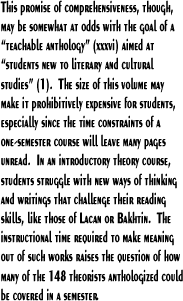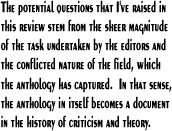1. The Norton Anthology of Theory and Criticism fulfills its promise to provide the “most wide-ranging and comprehensive collection of its kind” (xxxiii). Its 2,500-plus pages thoroughly cover both historical and contemporary thinkers, using fully annotated excerpts of appropriate length and self-containment to simultaneously challenge students and facilitate their understanding. The anthology represents Western classical, medieval, Renaissance, Enlightenment, Romantic, and Victorian theory and criticism; it includes canonical standards ranging from Aristotle to Kant as well as lesser known figures such as Christine de Pizan and what the editors term “'forgotten' figures such as Moses Maimonides” (xxxiii). Treatment of contemporary theorists is similarly broad. Selections illustrate formalism as well as cultural studies, Marxism and queer theory, reader-response theory as well as postcolonial studies. Including the voices of women and people of color and work from “previously underrepresented fields” (xxxiii), such as Native American or disability studies, is particularly noteworthy.
2. This promise of comprehensiveness, though, may be somewhat at odds with the goal of a “teachable anthology” (xxxvi) aimed at “students new to literary and cultural studies” (1). The size of this volume may make it prohibitively expensive for students, especially since the time constraints of a one-semester course will leave many pages unread. In an introductory theory course, students struggle with new ways of thinking and writings that challenge their reading skills, like those of Lacan or Bakhtin. The instructional time required to make meaning out of such works raises the question of how many of the 148 theorists anthologized could be covered in a semester. This question seems particularly relevant to the roughly 900 pages devoted to criticism from ancient times through the Victorian era. While the intellectual value of these thinkers cannot be questioned, their value to students who are neither specialists nor historians of theory can be. The editors rightly point out that the “influence” of these thinkers on theory's “development has continued up to the present” (7), but can students who are laboring to understand the present state of theory trace that influence at the same time?
3. The “Alternative Table of Contents” and “Introduction to Theory and Criticism” illustrate this potential schism between historical and contemporary theory. The “Alternative Table,” which follows the chronologically organized “Table of Contents,” usefully proposes four alternative ways of approaching the anthology; Part II, for example, lists works according to major genres addressed: “Drama” as well as “Popular Culture.” The lack of any overlap between Part I and Part III--indeed, the termination of a historical approach at the Victorian era--seems symptomatic of a possible division, especially in students' eyes, between these two sets of texts: Part I lists “Modern and Contemporary Schools and Movements” alphabetically, while Part III, “Historical Periods,” groups writers chronologically from the Classical through Victorian periods. The anthology's “Introduction” similarly provides students with no help identifying influences on the present; though incisive, its summaries of the theory and criticism of each era present the different periods as self-contained. Part IV of the “Alternative Table of Contents,” “Issues and Topics,” does go some way toward integrating these two blocks in its transhistorical groupings under headings such as “Authorship” and “The Vernacular and Nationhood.” Other interesting headings from this Part include “The Body,” “Ideology and Hegemony,” and “The Canon.” M. Keith Booker's instruction manual presents further “ways of configuring the materials” (xxxiv).
4. Like the selections, the anthology's apparatus is admirably wide-ranging and comprehensive. The “Introduction to Theory and Criticism” walks students through fifteen periods or major contemporary approaches, briefly yet clearly discussing “perennial issues and problems” and “key terms” (xxxiv). It offers not just an overview, but frames the field in two ways. First, it addresses the “antitheorists” who “advocate a return to studying literature for itself” (1). Second, it uses the questions “What is interpretation?” and “What is literature?” to compare different schools of thought. In the discussion that follows this set-up, the Introduction pairs related schools of thought, sometimes minimizing the second of the pair. Where “Poststructuralism” and “Deconstruction” receive balanced treatment, “Queer Theory,” “Race and Ethnicity Studies,” and “New Historicism” receive only one paragraph each in the far lengthier discussions of “Feminism,” “Postcolonial Studies,” and “Cultural Studies,” respectively. This marked imbalance does not appear to extend to the selections themselves.
5. Headnotes situate each figure--and each selection--in biographical, historical, and theoretical contexts. They outline the main arguments of the excerpt(s) with cross-references to other figures in the anthology and self-contained definitions of key terms. The headnote to Louis Althusser, for instance, explains the Lacanian Imaginary (1478). Headnotes also describe the author's other work. The selection “The Commitment to Theory” by Homi K. Bhabha does not address the ideas for which he is most well known, so the headnote helpfully discusses “the concept of hybridity” (2378). These two authors show how the listings of figures in the “Alternative Table of Contents” depend on the selections made by the editors: although he makes great use of its concepts in his work overall, Bhabha is not listed under “Psychoanalysis,” whereas Althusser is. Thus these listings in some cases reflect influences on an author's thought rather than indicating works that can be considered representative of a particular approach--Althusser would not illustrate the basic tenets of psychoanalysis to beginning students. Note also that the listings by school do not include opponents of that school. Each headnote concludes with an annotated selected bibliography of the author's major works that omits articles; for instance, Bhabha's headnote tells the reader the title of his collected essays, but not where to go to read about the concepts, like hybridity, described in the headnote. Of particular interest is the annotated selected bibliography of responses to the author's work that closes each headnote.
6. The “Selected Bibliography of Theory and Criticism” that follows the selections names major English-language sources through the end of the twentieth century in six categories: Theory and Criticism Bibliographies; Anthologies of Theory and Criticism (listed by period); Histories of Criticism and Theory (listed by period); Glossaries, Encyclopedias, and Handbooks (mostly general rather than geared to a specific approach like psychoanalysis, for example); Introductions and Guides; and Modern and Contemporary Critical Schools and Movements. The last category contains sixteen sections that largely mirror the schools named in the text proper, with one notable exception. What had been designated Race and Ethnicity Studies receives four detailed individual bibliographic entries: African American Criticism and Theory, Asian American Criticism and Theory, Chicano/Chicana Studies, and Native American Studies. Again, almost all of the texts listed are books rather than articles. Each entry follows the same five-paragraph format: 1. groundbreaking texts; 2. introductions and overviews; 3. anthologies; 4. reference sources; and 5. crossover texts. In its recognition of the interdisciplinary intersections and overall eclecticism that have proved so fruitful in recent theory, the fifth paragraph of each entry holds special value. As the editors admit, it is here that “many of the most innovative writings” (xxxv) have appeared, and it is here that the anthology demonstrates its comprehensiveness by listing, for instance, feminist responses to science. These listings also provide a useful counterpoint to the labeling of thinkers that, while necessary in a project such as this anthology, necessarily flattens the polyvocality of most theorists and reifies boundaries between them.
7. Following an “Author/Title
Index,” a very complete “Subject Index” containing “terms, concepts,
persons, and works mentioned in the Anthology” (2565) closes this useful
volume. The potential questions that I've raised in this review stem
from the sheer magnitude of the task undertaken by the editors and the
conflicted nature of the field, which the anthology has captured.
In that sense, the anthology in itself becomes a document in the history
of criticism and theory.
|
|

|
|

|
|
